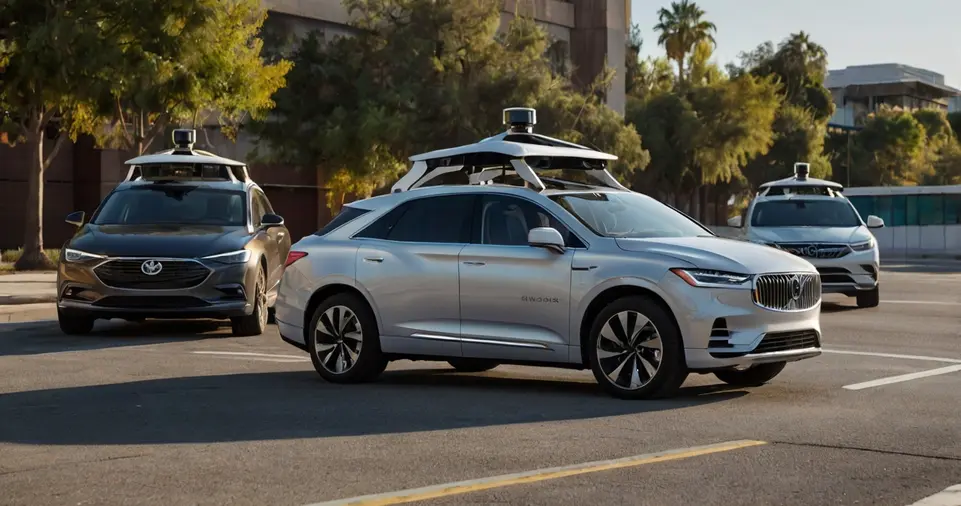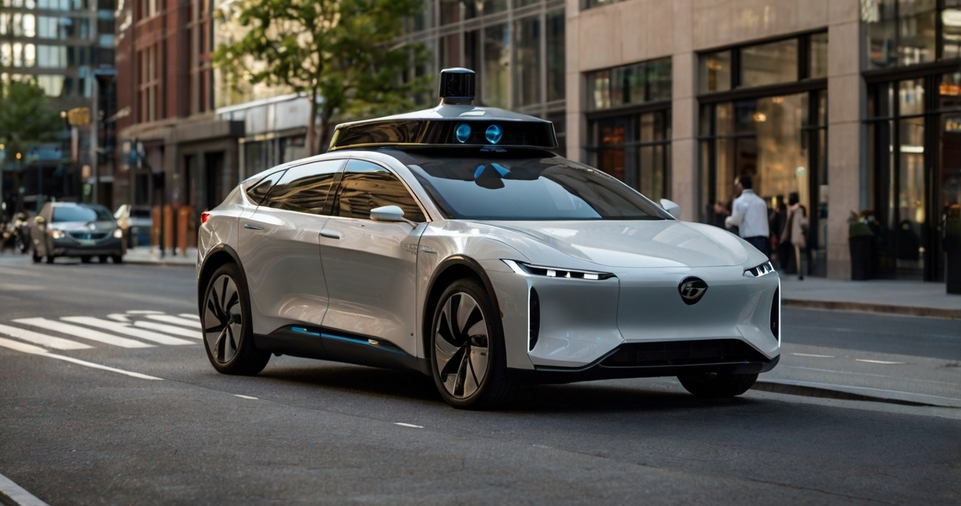Autonomous vehicles (AVs), commonly known as self-driving cars, represent a transformative technology in the automotive and transportation industries.
These vehicles operate without human intervention, using advanced sensors, software, and machine learning algorithms to navigate, make decisions, and safely transport passengers.
The promise of AVs lies in their potential to revolutionize mobility, improve safety, reduce traffic congestion, and lower carbon emissions.
However, the widespread adoption of self-driving cars also brings several challenges, including ethical considerations, regulatory hurdles, and job displacement concerns.
In this article, we will delve into the technology behind autonomous vehicles, the various levels of automation, and their potential impact on society.
From the sensors and algorithms that power these vehicles to the broader economic and environmental implications, this article aims to provide a comprehensive overview of how autonomous vehicles work and the far-reaching effects they may have in the future.
As this technology continues to evolve, it has the potential to reshape not only how we drive but also how we live, work, and interact with the world around us.
How Autonomous Vehicles Work
Sensors and Perception Technology
At the core of an autonomous vehicle’s operation lies an array of sophisticated sensors and cameras.
These technologies enable the vehicle to perceive its environment in real-time, detecting obstacles, pedestrians, other vehicles, and road features.
Among the most critical sensors used in AVs are:
LIDAR (Light Detection and Ranging)
This sensor uses laser beams to create a 3D map of the environment, measuring the distance to objects in the vehicle’s path.
LIDAR is crucial for creating high-resolution, real-time maps that help the vehicle navigate safely.
Radar
Radar sensors help detect objects at longer distances and in adverse weather conditions like fog, rain, or snow.
These sensors are particularly valuable for monitoring surrounding vehicles and obstacles.
Cameras
Autonomous vehicles are equipped with high-definition cameras that capture images and video of the vehicle’s surroundings.
These cameras help with recognizing traffic signs, signals, lane markings, and other vehicles.
Ultrasonic Sensors
These sensors are primarily used for short-range detection, helping the vehicle understand its proximity to objects like curbs and parked cars.
Together, these sensors work in harmony to provide the autonomous vehicle with a comprehensive understanding of its environment, enabling it to make intelligent decisions as it drives.
Artificial Intelligence and Machine Learning
The real power behind autonomous vehicles lies in their ability to process the massive amounts of data generated by these sensors.
This is where artificial intelligence (AI) and machine learning (ML) play a critical role.
AI algorithms analyze the data in real-time, interpreting sensor readings and predicting the actions of other vehicles, pedestrians, and road users.
Machine learning models help the vehicle “learn” from past driving scenarios, improving its decision-making process over time.
For instance, the vehicle can recognize patterns, such as how other drivers typically react in specific situations, and adjust its behavior accordingly.
Over time, the AVs become better at handling complex driving conditions, such as merging onto highways, navigating intersections, or dealing with construction zones.
Mapping and GPS Technology
In addition to sensors and AI, autonomous vehicles rely on detailed, high-definition maps and Global Positioning System (GPS) technology to navigate.
These maps contain precise information about the road network, including lane configurations, traffic signs, speed limits, and topographical data.
While GPS provides the vehicle’s approximate location, high-definition maps ensure the vehicle can accurately determine its position within a few centimeters.
These maps are constantly updated to reflect any changes in road conditions, such as construction work, road closures, or accidents, ensuring the vehicle can adapt to dynamic environments.
The combination of GPS and HD mapping enables AVs to plan routes, adjust driving behaviors, and make real-time decisions about the best path to take.
Levels of Autonomous Vehicles

The Society of Automotive Engineers (SAE) defines six levels of vehicle autonomy, ranging from Level 0 (no automation) to Level 5 (full automation).
These levels categorize vehicles based on the degree of human intervention required.
Level 0: No Automation
At Level 0, there is no automation. The human driver is responsible for every aspect of the driving task, including steering, acceleration, and braking. Most cars on the road today fall into this category.
Level 1: Driver Assistance
Level 1 vehicles include basic driver assistance systems, such as adaptive cruise control or lane-keeping assistance.
While these systems help with specific driving tasks, they still require constant human oversight.
Level 2: Partial Automation
Level 2 automation, seen in vehicles with advanced driver-assistance systems (ADAS), allows the car to control both steering and acceleration.
However, the human driver must remain engaged and ready to take control at any moment. Tesla’s Autopilot system is a well-known example of Level 2 automation.
Level 3: Conditional Automation
At Level 3, the vehicle can take over all driving tasks, including steering, acceleration, and braking, in certain conditions, such as highway driving.
However, the driver must be prepared to intervene if requested by the system. Audi’s Traffic Jam Pilot is an example of a Level 3 system.
Level 4: High Automation
Level 4 automation allows the vehicle to operate autonomously within specific environments, such as urban areas or geo-fenced zones, without the need for human intervention.
The car can handle all driving tasks, including complex maneuvers. However, Level 4 vehicles may require a human driver to take over if they exit the designated operational area.
Level 5: Full Automation
At Level 5, there is no need for a human driver at all. The vehicle is fully autonomous and can operate in all environments and conditions without any human intervention.
Level 5 vehicles would have no steering wheel, pedals, or other traditional driver controls.
The Impact of Autonomous Vehicles

Improved Safety and Reduced Accidents
One of the most significant benefits of autonomous vehicles is the potential for enhanced safety.
Human error is responsible for over 90% of traffic accidents, and by removing the human element from driving, AVs could significantly reduce accidents and fatalities on the road.
Autonomous vehicles can respond to emergencies faster than humans, avoiding potential collisions and making more precise decisions in complex traffic situations.
Moreover, AVs can be programmed to follow traffic laws strictly, reducing instances of reckless driving, speeding, or distracted driving.
Traffic Congestion Reduction
Autonomous vehicles have the potential to reduce traffic congestion significantly.
Through vehicle-to-vehicle (V2V) communication, AVs can share information with one another, such as speed, location, and route plans.
This collaboration enables vehicles to optimize traffic flow, reduce bottlenecks, and even form platoons—groups of cars traveling in tight formation to minimize air resistance and improve fuel efficiency.
Additionally, AVs can adjust their speed and routes based on real-time traffic data, further reducing congestion and commute times.
The efficiency gained from autonomous driving could transform urban planning, making cities more livable by reducing the need for large parking lots and increasing green spaces.
Environmental Benefits
Autonomous vehicles can contribute to environmental sustainability in several ways.
For example, optimal route planning and driving techniques can reduce fuel consumption, lowering greenhouse gas emissions.
Since AVs can operate more efficiently, they can help decrease overall energy consumption, especially when combined with electric vehicles.
As more self-driving cars are integrated into shared mobility services like ride-hailing and car-sharing, the number of vehicles on the road could decrease, further reducing emissions and energy use.
Increased Accessibility
Autonomous vehicles could revolutionize mobility for individuals who are unable to drive due to age, disability, or other reasons.
AVs provide an opportunity for these individuals to gain greater independence and access to transportation.
Elderly people, for instance, who may no longer feel comfortable driving, could use AVs to maintain their mobility and quality of life.
Moreover, autonomous vehicles could also improve access to transportation in underserved areas, offering an affordable, efficient alternative to public transit or traditional car ownership.
Challenges and Concerns of Autonomous Vehicles
Job Displacement
While AVs promise many benefits, one significant concern is job displacement.
Industries such as trucking, delivery services, and taxi driving could see substantial job losses due to automation.
According to some estimates, millions of jobs in driving-related sectors could be affected by the widespread adoption of autonomous vehicles.
As a result, governments and companies will need to invest in retraining and reskilling workers, ensuring that those displaced by AVs can find new employment opportunities in emerging industries related to autonomous vehicle development, maintenance, and management.
Ethical and Legal Challenges
The introduction of autonomous vehicles also raises numerous ethical and legal issues.
One of the most pressing concerns is liability—if an AV is involved in an accident, determining who is at fault can be complex.
Is it the manufacturer, the software developer, or the car owner? These questions will require legal frameworks to address the new realities of AVs.
Another ethical issue involves decision-making in unavoidable crash scenarios.
For instance, if an AV must choose between two equally dangerous options, such as hitting a pedestrian or swerving into oncoming traffic, who decides how the vehicle should act?
Cybersecurity and Privacy
As autonomous vehicles rely heavily on data and connectivity, cybersecurity is another critical concern.
Hackers could potentially take control of a vehicle’s systems, putting passengers and pedestrians at risk.
Furthermore, AVs collect vast amounts of data about passengers, their travel patterns, and preferences, which raises privacy concerns regarding how this data is stored, shared, and used.
Infrastructure and Regulation
The widespread deployment of autonomous vehicles will require significant updates to infrastructure and regulatory frameworks.
Governments will need to implement new laws and safety standards for AVs, while cities may need to redesign roads to accommodate the technology, such as dedicated lanes or better communication systems for vehicle-to-infrastructure (V2I) communication.
Conclusion
Autonomous vehicles are poised to revolutionize the way we think about transportation.
While the technology holds immense potential to improve safety, reduce traffic congestion, and increase accessibility, it also raises significant challenges that need to be addressed.
These include concerns over job displacement, ethical decision-making, and the need for robust legal and regulatory frameworks.
As autonomous vehicles continue to evolve and mature, they will reshape our cities, economies, and daily lives.
The widespread adoption of AVs will likely come with both benefits and challenges, but one thing is certain: autonomous vehicles will play a critical role in the future of transportation.

